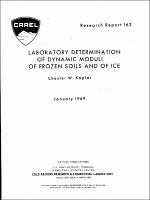Please use this identifier to cite or link to this item:
https://hdl.handle.net/11681/5722Full metadata record
| DC Field | Value | Language |
|---|---|---|
| dc.contributor.author | Kaplar, Chester W. | - |
| dc.date.accessioned | 2016-03-21T21:08:05Z | - |
| dc.date.available | 2016-03-21T21:08:05Z | - |
| dc.date.issued | 1969-01 | - |
| dc.identifier.uri | http://hdl.handle.net/11681/5722 | - |
| dc.description | Research Report | - |
| dc.description.abstract | Abstract: This report presents a summary of results of laboratory investigations of frozen soils and ice to determine the elastic moduli by the dynamic (sonic) method. The elastic moduli were indirectly obtained by measuring the fundamental resonant frequencies of flexural, longitudinal, and torsional vibrations induced in prismatic beams by electromagnetic means. Vibration tests were performed on a total of 56 specimens representing 12 different materials (8 natural soil types, ranging from coarse-grained to fine-grained; 2 blended soils; a natural peat; laboratory-frozen ice and natural lake ice, at temperatures ranging from approximately +32°F to -10°F). Elastic wave velocities (longitudinal and torsional) were computed for each material in the range of test temperatures studied. All soils were saturated or were close to saturation. The dynamic moduli of elasticity of the frozen soils were found to increase with a decrease in temperature, the greatest rate of increase occurring between +32°F and +20°F. Coarse granular soils gave the highest values and clays the lowest in the ratio of more than 4 to 1. Dynamic Young's modulus, E, computed from flexural vibrations was usually lower than dynamic E computed from longitudinal vibrations. Average values of dynamic Poisson's ratio for all soil types computed from average values of E and G (longitudinal vibrations) ranged from 0.26 to 0.38. Values of Poisson's ratio for the various soil types did not conform to any logical pattern related to temperature or soil type. The dynamic moduli of elasticity of ice showed only slight dependence on temperature, and test; values were more consistent than those of the soils. Natural lake ice was least temperature dependent and gave the most consistent results. Dynamic moduli of ice E (longitudinal vibration) and G, compared closely with values reported by other investigators. Average values of Poisson's ratio for ice were reasonable but less consistent, ranging from 0.30 to 0.41. | - |
| dc.publisher | Cold Regions Research and Engineering Laboratory (U.S.) | - |
| dc.publisher | Engineer Research and Development Center (U.S.) | - |
| dc.relation | http://acwc.sdp.sirsi.net/client/en_US/search/asset/1013062 | - |
| dc.relation.ispartofseries | Research report (Cold Regions Research and Engineering Laboratory (U.S.)) ; 163. | - |
| dc.rights | Approved for public release; distribution is unlimited. | - |
| dc.source | This Digital Resource was created from scans of the Print Resource | - |
| dc.subject | Frozen soil | - |
| dc.subject | Frozen ground | - |
| dc.subject | Permafrost | - |
| dc.subject | Soils | - |
| dc.subject | Ice | - |
| dc.subject | Dynamic moduli of elasticity | - |
| dc.subject | Vibration | - |
| dc.subject | Elasticity | - |
| dc.subject | Elastic wave velocity | - |
| dc.subject | Young's modulus | - |
| dc.subject | Poisson's ratio | - |
| dc.title | Laboratory determination of dynamic moduli of frozen soils and of ice | - |
| dc.type | Report | en_US |
| Appears in Collections: | Research Report | |
Files in This Item:
| File | Description | Size | Format | |
|---|---|---|---|---|
| CRREL-Research-Report-163.pdf | 2.98 MB | Adobe PDF |  View/Open |